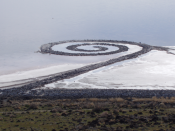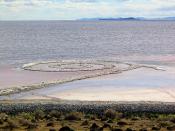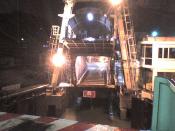Spiral Jetty, 1970,Mud, salt crystals and rock.
Partially Buried Woodshed, 1970,Woodshed and earthRobert Smithson was an American artist, famous mainly for his land art, born in 1938 in Passaic, New Jersey. He studied painting and drawing in New York at the Art Students League. His artworks were influenced by beef cake magazines, pop art and science fiction. However, in 1964 Smithson took at different approach to art, joining the art form of minimalism. Through this and his writings, Smithson became interested in mathematical impersonality which was art generated by mathematical algorithms. His later writings of 18th - 19th conceptions of land forms greatly influenced his later land art. Smithson became fascinated by dump trucks moving earth and rock during 1967. He described these sites as antiques with Smithson publishing the essay "A Sedimentation of the Mind: Earth Projects", thereby bringing about many land artists. Smithson was greatly interested in sites which had deformities.
He said that the best sites for land art were ones that have been disrupted by industry, urbanization or nature. Spiral Jetty and Partially Buried Woodshed are both examples of his later earth works.
Spiral Jetty is considered to be a master piece of the American sculptor Robert Smithson. It is the most well known work by him. It is an earthwork sculpture built out of mud, salt crystals, basalt rocks, earth and water. Built during 1970, the earthwork is situated at Rozel Point, on the north east shore of the Great Salt Lake in Utah. It is 1500ft long and 15ft wide. The work can be interpreted as a symbol of life and death. It expands and contracts as the sea levels rises, sometimes being fully submerged, however because of recent droughts it has surfaced. . Also, over the years, it...


